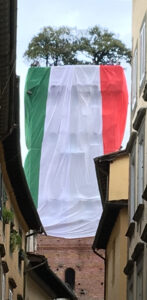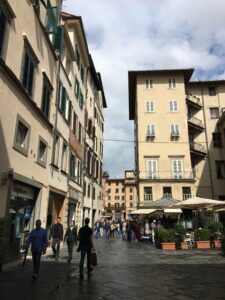
~ Jasmine
At almost every turn in the heart of the city, the intoxicating scent of jasmine flows from walled gardens and around doorways. I am sure my mother, Joan or Giovanna as she was christened, noticed it too when she walked to school with her sister who was just a year and a half older. Even though she was just two or three, Nonna Marianna wanted Mom to go to school because she had three children under the age of five. They chose a private school, Vittorino da Feltri (later named Villa Gioiosa), so that they wouldn’t have to pledge allegiance to the Fascists. Mom loved the school’s Montessori approach because she got her very own symbol – a little house – embroidered on her school smock, lunchbox and cubicle – they were exclusively hers. She didn’t mind at all that she stayed in the same grade for three years, doing a curriculum of “mezza prima, prima, e prima assoluta”… (half of first, real first grade, and the ultimate first grade).
Nonno Gino standing on the stoop of the Savoia, above.
~ The aroma of coffee and cigarettes
The memorable scent of cigarette smoke and fine coffee permeated the clothes of Nonno Gino and his partner, Natale Pancaccini. Their bar owed its success to its outstanding proprietary blend of coffee, exquisite pastries – their mille feuille was legendary – and ice cream. The caffe` was a de facto men’s club, so try as she might, my zia Gina was never permitted to bake there or work as a cashier, and only on the rarest occasions would a wife accompany her industrialist husband to the bar for coffee; women were expected to frequent the Stella Polare caffe` across the piazza.
A side room featured three billiards tables with huge carved legs, but no gambling. The place was packed after sporting events, and benefited from being close to where private and government business was transacted: the SALOV (the hugely successful Society of Lucchese Vintners and Olive Oil producers) had its headquarters on the floors above the caffe`, the provincial and federal government offices were in the Palazzo Ducale across the street. The caffe`’s elegant walnut-panelled space was also frequented other professionals who worked around the city center, such as lawyers and accountants, and bankers including those from the Bank of America and Italy (later Bank of America, which Mom proudly remembered was founded in San Francisco by Italian-American Amadeo Giannini).
Credit: Free photo Flowers Yellow Mimosa Nature Women’s Party Flower – Max
~ Mimosa: the unscented flowers of mourning
My nonno Gino’s office was also on the floor above the caffe. My mother would work there to help my nonno check his books – though she said it was amazing to see how he could quickly and accurately total a page-long column of numbers in his head. During the war, he routinely paid his employees more than the wage dictated by the government, because he failed to see how anyone could live on the mandated sum. He also remarked that he’d probably make more money if his standards were lower because the price of coffees and liquor were set by the state and couldn’t be exceeded; one such bar frequented by country folk went so far as to advertise that it had day-old pastries from the Savoia, and raked in plenty of customers. But Nonno Gino had his standards. His office also had a balcony overlooking via Vittorio Veneto and Piazza Grande. Nonna remembered watching a parade from that balcony for war hero and aviator Carlo del Prete. She was five years old and had been given mimosa to throw down upon his hearse.
~ Frost and freezing wrists
Snow fell on Lucca for the first time in 1929: over six inches of it! To celebrate, Nonno Gino carried a bundled up Nonna, who was six years old, to the end of Corso Garibaldi and placed her on top of an embankment under one of the mura lions, then he let her jump down into the snowdrift below – the fluffy stuff came up to her knees – she was shocked and thrilled.
The next day, it was gone. Mom frequently commented on how cold and damp the winters were in Lucca even if it didn’t snow. There was no central heat, only “mandolini” (boxes containing warm coals) that were put in their beds to help warm the hemp sheets before they jumped in. Mom and Gina slept in the same bed to help keep each other warm. Mom grew like a weed and was always freezing because she couldn’t get her nightgown’s sleeves to cover her wrists. She remembered being delighted when Nonna Marianna sewed her a flannel nightgown with extra-long sleeves.
~ Basswood flowers perfuming the air with intense sweetness
At the opposite end of via San Paolino, there is a tree-lined baluardo where Nonna Marianna or one of the girls who lived in to help her, would take the children to play – no decent family would let their kids play in a piazza, or the street! – children required fresh air and green space. On every occasion, Nonna would put her head between the bars of a gate that blocked entry to a mysterious courtyard within the wall. One day, she couldn’t get her head out of the gate! This was a major crisis. She panicked, but there was little to do. Eventually she was able to get it out at a new and different angle. There was no need for a reprimand. She never tried that again!
~ Wafts of freshly cut grass
By the time Mom was ready for second grade, the regime was requiring even families with children at private schools to pledge allegiance to fascism, so Gina, Giovanna and Carlo started attending public school. Carlo went to the boys’ elementary school, while the girls went to the “Scuola Elementare Giovanni Pascoli – sezione femminile” in via San Nicolao, at the opposite end of via San Paolino, near Porta Elisa. Happily, Angela Francesconi, Nonna’s best friend, was in the same class taught by Iole Magherini. Ms. Magherini had 40 little girls in her class and “looped” with them from 1st thru 5th grade, after which they went to middle school. She ran a tight ship but cared deeply about her students, keeping her “coccoline” (her most attentive, favorite) students near the front but made sure that all had what they needed and were well fed: she organized the children who were better off to anonymously bring in breakfast for the girls who were unlikely to have gotten anything at home. Ms. Magherini took a hands-on approach to teaching the girls: they learned how to grow and harvest silkworms, what a heart looked like and how it worked by dissecting a pig’s heart, and where the aqueducts started and how they worked by hiking as a class to the “water temple” at Monte San Quirico. They experienced how the solar system worked by putting on a pageant dressed in costume as the sun, moon, planets, and stars. They learned to dance the minuet (Boccherini’s, of course), and even how to weave ribbons around a May Pole. For the holidays and other special occasions, she taught them a gracious toast – in fact, Mom and Angela recited it in unison to celebrate their 90th birthdays! My Mom loved her teacher dearly. Once Mom said, she wanted to give her teacher a gift, so she carefully peeled an orange in a spiral, reassembled it, and put it on the teacher’s desk. Mom was so pleased when Ms. Magherini saw it and exclaimed: “What a beautiful orange!” and opening it added, “What a wonderful surprise!”
- For a map to the sites mentioned, click the link below…
- “Scents & Memories” Locations

